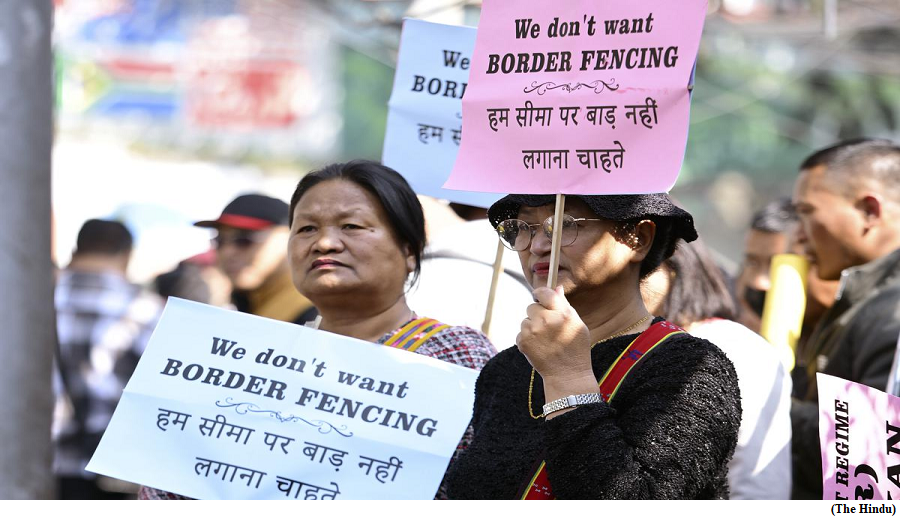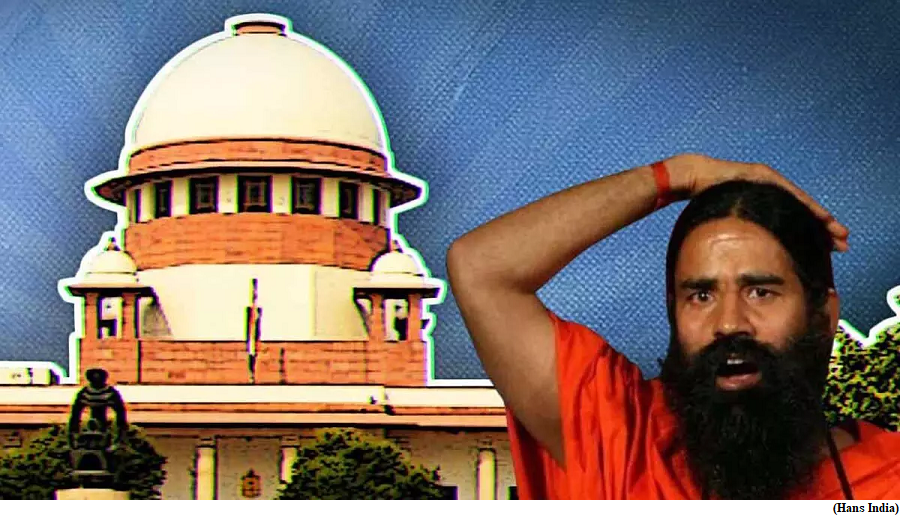The resolutions against Centre border plan (GS Paper 2, International Relation)

Why in news?
- Recently, the Mizoram Assembly and the Nagaland Assembly adopted a resolution to oppose the Centre’s decision to fence the 1,643 km long porous India-Myanmar border and scrap the Free Movement Regime (FMR) agreement that allows cross-border movement up to 16 km without travel documents.
What led to the resolutions?
- The Centre has decided to fence the India-Myanmar border and scrap the FMR implemented in 2018 as part of India’s Act East policy for cultural, business, and terrestrial connectivity to Southeast Asia and beyond.
- The Centre decided to suspend the FMR ostensibly to thwart illegal migration of people, the smuggling of drugs, arms and ammunition, and the cross-border movement of extremists.
- The decision was influenced by the Manipur government’s push after the ethnic violence between the Meiteis and the Kuki-Zo people began on May 3, 2023 for fencing the border to stop Myanmar nationals from settling in the State illegally.
- Arunachal Pradesh and Manipur welcomed the Centre’s decision but Mizoram and Nagaland, the other two States bordering Myanmar, opposed it because of the ethnic composition along the border “imposed by the British rulers” and their age-old social, cultural, and trade links.
Why is the India-Myanmar border in focus?
- India has had an on-off diplomatic relationship with Myanmar since 1948 when the latter attained independence from the British.
- India’s border districts absorbed waves of refugees following military coups and pro-democracy movements in Myanmar in the 1960s, 1980s, and after February 2021.
- The growing Chinese influence in Myanmar made India establish warmer relationships with Yangon (Nyapyidaw later), but certain issues remained.
- The areas of Myanmar bordering India are controlled by ethnic militias and extremist groups such as the Arakan Army, Chin National Front, and the National Socialist Council of Nagaland (Khaplang), some of which have sheltered northeast-based outfits such as the United Liberation Front of Asom.
- These outfits have carried out hit-and-run operations in India. Although the Myanmar border is guarded by the paramilitary Assam Rifles, the terrain and lack of fencing are said to have made it difficult to check the movement of extremists and the trafficking of drugs, arms, and other contraband items.
What do the resolutions say?
- Much of India’s present-day northeast was temporarily under Burmese occupation until the British pushed them out in the 1800s. The victors and the vanquished signed the Treaty of Yandaboo in 1826, leading to the current alignment of the boundary between India and Burma, later renamed Myanmar.
- The border divided people of the same ethnicity and culture specifically the Nagas of Nagaland and Manipur and the Kuki-Chin-Mizo communities of Manipur and Mizoram without their consent.
- Asserting the right of the Mizo-Chin people to live together, Mizoram’s Home Minister K. Sapdanga, moving the resolution, said a fence would divide their ancestral land and alienate people with blood ties. Nagaland’s Deputy Chief Minister, Y. Patton, said while moving the resolution in the State Assembly that the Centre’s move would disrupt the age-old ties of the Naga people living on both sides of the international border.
What impact will the resolutions have?
- In March 2021, the Supreme Court said there was no harm in State Legislative Assemblies adopting resolutions against central laws like the Citizenship (Amendment) Act. It said that such resolutions are merely “opinions” of the majority members of an Assembly and do not have the force of law.
- Some of the northeast States have adopted several resolutions over the decades but these have had little impact apart from reflecting the sentiments of the people, although a section of Mizos in “dry”
- Mizoram are not averse to fencing the India-Myanmar border primarily because of the inflow of drugs.
Why did the Court penalise Patanjali?
(GS Paper 2, Judiciary)
Why in news?
- Recently, the Supreme Court restrained Patanjali Ayurved from discrediting allopathy in its campaigns, and from advertising products that claim to cure chronic conditions.

Details:
- Patanjali’s ads present its products to people as a ‘permanent relief’, which is “misleading” and “a violation of the law”, the Bench remarked, citing provisions of the Drugs and Magic Remedies (Objectionable Advertisements) Act, 1954 (DMR&OA) and its Rules.
- The Bench also issued a contempt notice against Patanjali Ayurved (co-founded by yoga guru Baba Ramdev) and Managing Director Acharya Balkrishna for failing to adhere to directions passed in November 2023.
What is the case?
- The Indian Medical Association (IMA) in 2022 filed a petition in response to a Patanjali advert titled: “Save yourself and the country from the misconceptions spread by pharma and medical industry.”
- The petition presented two grievances that the company is denigrating allopathy through a “continuous, systematic, and unabated spread of misinformation”, while making exaggerated claims about its drugs which are purportedly based on “scientific, evidence-based medicines”.
- In December 2022, Nepal’s drug regulator blacklisted Patanjali’s Divya Pharmacy for failing to comply with WHO’s drug manufacturing standards.
- A Bench of Justices in November warned Patanjali from advertising a permanent cure and threatened to impose a penalty of ₹1 crore for every product which promises a ‘permanent’ treatment.
- Patanjali assured the court against future violations, “especially relating to advertising or branding of products”, adding “that no casual statements claiming medicinal efficacy or against any system of medicine will be released to the media in any form”. The company failed on both counts.
What does the law say?
- The DMR&OA regulates false medical advertisements in India. People or entities can be sentenced up to six months imprisonment, and/or a fine for the first offence. The CPA also penalises misleading advertisements and carries a sentence that can extend to two years.
- Section 3 of the DMR&OA prohibits ads for the “diagnosis, cure, mitigation, treatment or prevention of any disease, disorder or condition specified in the Schedule”. The Schedule includes “diabetes”, “heart diseases”, “glaucoma” and 51 other diseases.
- In addition, Section 4 prohibits any “misleading advertisement”, which “directly or indirectly gives a false impression regarding the true character of the drug”, “makes a false claim for the drug”, or “is otherwise false or misleading in any material particular.”
- The Uttarakhand Ayurvedic and Unani Services in 2023 ordered Patanjali to remove all ‘misleading’ ads and also banned the production of five drugs. The ban was reversed four days later.
What are limitations in the law?
- The DMR & OA is an imperfect law, suggest medical practitioners and experts. These limitations allow companies like Patanjali to go unscathed despite repeated offences.
- Convictions under the Magic Remedies Act are few and far between. In 2017, the Ministry of AYUSH signed a memorandum of understanding with the Advertising Standards Council of India to identify illegal and misleading advertisements and agreed to bring cases to the notice of the State Regulatory Authorities.
- Between August 2018 and June 2021, the Ministry found 14,876 instances of misleading advertisements of Ayurveda, Siddha, Unani and Homoeopathy drugs, which were forwarded to State regulatory agencies.
What next?
- The Supreme Court has placed a temporary ban on all advertisements of medicinal products, refusing to even permit ads “without adjectives”. The case will be heard next on March 19.



